Metal Fireplace Box: A Comprehensive Overview
A metal fireplace box, also frequently referred to as a fireplace insert or firebox, is a self-contained heating appliance designed to fit within an existing fireplace opening. It functions as a more efficient and controlled alternative to a traditional open fireplace. Constructed primarily from metal, typically steel or cast iron, these boxes offer enhanced heating capabilities, improved safety features, and reduced emissions compared to their open-hearth counterparts. Understanding the nuances of metal fireplace boxes, their construction, functionality, and selection criteria, is crucial for homeowners seeking to upgrade their fireplace system.
The evolution of the fireplace has led from simple open hearths to enclosed combustion systems. The open fireplace, while aesthetically pleasing, suffers from significant energy inefficiency. A large portion of the heat generated escapes up the chimney, and the draw of the chimney can actually pull heated air from the rest of the house. This inefficient heat transfer led to the development of the fireplace insert, which aims to capture and radiate a greater percentage of the heat produced by the fire.
Metal fireplace boxes represent a significant improvement in fireplace technology. They provide a controlled combustion environment, allowing for more complete burning of fuel and reducing the release of smoke and pollutants. Furthermore, the enclosed design dramatically improves heat retention and distribution. The metal construction, coupled with features like insulated fireboxes and blowers, allows these units to efficiently radiate heat into the room, making them a viable supplemental heating source.
Key Point 1: Materials and Construction of Metal Fireplace Boxes
The materials used in the construction of a metal fireplace box directly influence its durability, efficiency, and heat retention capabilities. Steel and cast iron are the primary materials used, each offering distinct advantages.
Steel Fireplace Boxes: Steel inserts are generally lighter than cast iron models, which can simplify installation. They typically heat up more quickly but may also cool down faster. Steel fireboxes are often constructed from heavy-gauge steel, providing adequate strength and resistance to warping under high temperatures. The steel may be treated with various coatings to enhance its rust resistance and longevity. Welding techniques are critical in steel firebox construction to ensure airtight seams and structural integrity. The quality of the steel and the welding directly impacts the overall lifespan and performance of the unit.
Cast Iron Fireplace Boxes: Cast iron inserts are known for their exceptional heat retention properties. They absorb heat slowly but release it over a longer period of time, providing a more consistent and even heat output. Cast iron is also highly durable and resistant to warping, making it a long-lasting material choice. However, cast iron inserts are significantly heavier than steel models, requiring more robust support and potentially more challenging installation. The casting process is crucial to the quality of the cast iron firebox, ensuring there are no weak points or imperfections that could compromise its structural integrity. Cast iron fireboxes are often preferred in regions with extended heating seasons due to their superior ability to maintain a comfortable room temperature.
Beyond the primary material of the firebox itself, other components contribute to the overall construction and performance. Firebrick lining is a common feature, providing insulation within the firebox and protecting the metal from direct exposure to extreme temperatures. Baffles are strategically placed within the firebox to direct the flow of combustion gases, maximizing heat extraction and reducing emissions. Doors, typically made of cast iron or steel with glass inserts, allow for viewing the fire while maintaining a controlled combustion environment. Blowers, often integrated into the design, circulate heated air out into the room, improving heat distribution and overall efficiency.
Key Point 2: Functionality and Operational Aspects
The functionality of a metal fireplace box extends beyond simply providing heat. These units are designed to offer enhanced control over the combustion process, improve efficiency, and reduce environmental impact. Key aspects of their functionality include combustion control, heat distribution, and emissions management.
Combustion Control: Modern metal fireplace boxes incorporate features that allow for precise control over the air supply to the fire. Air inlets, often adjustable, regulate the amount of oxygen available for combustion, enabling the user to control the burn rate and heat output. A controlled air supply ensures more complete combustion of the fuel, minimizing the production of smoke and pollutants. Some models incorporate advanced combustion technologies, such as secondary air injection systems, which introduce additional air to burn off unburned gases. This further reduces emissions and improves efficiency. The ability to control combustion allows homeowners to tailor the heat output to their specific needs and preferences, making the fireplace box a more versatile heating option.
Heat Distribution: Metal fireplace boxes are designed to maximize heat transfer from the fire to the living space. The metal construction itself radiates heat, warming the surrounding area. However, many units also incorporate blowers to actively circulate the heated air. A blower forces air across the heated surfaces of the firebox, capturing the heat and directing it out into the room. This significantly improves the distribution of heat, ensuring that the warmth is spread evenly throughout the space. Some models offer variable blower speeds, allowing the user to adjust the airflow to suit their needs. The effectiveness of the heat distribution system is a crucial factor in determining the overall heating performance of the fireplace box.
Emissions Management: A key advantage of metal fireplace boxes over traditional open fireplaces is their ability to significantly reduce emissions. The controlled combustion environment allows for more complete burning of the fuel, minimizing the production of smoke, particulate matter, and other pollutants. Many models meet stringent EPA (Environmental Protection Agency) emission standards, making them a more environmentally responsible heating option. Features like catalytic converters and secondary combustion systems further reduce emissions. Selecting a model that meets or exceeds EPA standards is crucial for homeowners who are concerned about air quality and environmental impact.
Key Point 3: Selection Criteria and Installation Considerations
Choosing the right metal fireplace box involves careful consideration of various factors, including size, heating capacity, fuel type, and installation requirements. Proper installation is essential for safe and efficient operation.
Sizing and Heating Capacity: The size of the firebox should be appropriately matched to the size of the fireplace opening and the area to be heated. An undersized unit will not provide adequate heat, while an oversized unit may be inefficient. Heating capacity is typically measured in BTUs (British Thermal Units), and the required BTU output will depend on the square footage of the room, the insulation levels, and the climate. Consulting with a professional fireplace installer is recommended to determine the appropriate size and heating capacity for a specific application.
Fuel Type: Metal fireplace boxes can be designed to burn wood, gas (natural gas or propane), or pellets. Wood-burning inserts offer the traditional ambiance of a wood fire but require a supply of seasoned wood and regular maintenance. Gas inserts are more convenient, offering push-button ignition and consistent heat output, but require a gas line connection. Pellet inserts burn compressed wood pellets, providing a balance of convenience and efficiency. The choice of fuel type will depend on personal preferences, fuel availability, and convenience considerations.
Installation Requirements: Installing a metal fireplace box is not a do-it-yourself project and should be performed by a qualified professional. Proper installation is crucial for ensuring safe and efficient operation. The installation process typically involves preparing the fireplace opening, installing a chimney liner, connecting the firebox to the chimney, and securing the unit in place. A chimney liner is essential for protecting the existing chimney from the corrosive effects of combustion gases and for ensuring proper draft. Gas inserts require the connection of a gas line, which must be performed by a licensed gas fitter. After installation, a thorough inspection is necessary to verify that the unit is functioning correctly and that all safety requirements are met. Regular maintenance, including chimney cleaning and inspection, is essential for ensuring the continued safe and efficient operation of the metal fireplace box.
In addition to these practical considerations, aesthetic factors play a role in the selection process. Metal fireplace boxes are available in a wide range of styles and finishes to complement various home décor themes. Options include traditional cast iron designs, contemporary steel models, and decorative glass fronts. Selecting a model that aligns with the homeowner's aesthetic preferences will enhance the overall appeal of the fireplace.

What Is A Fireplace Firebox Full Service Chimney

Selecting The Right Firebox For Wood Fireplaces Old World Stoneworks
Metal Firebox Removal Help Hearth Com Forums Home
Heatform Hearth Com Forums Home

What Is A Fireplace Firebox Full Service Chimney

Electric Traditional Black Metal Fireplace Box Insert With Heat Functionality

Brick Effect Box Bioethanol Wall Mounted Vent Free Metal Fireplace By British Fires

Ceramic Box For Fireplace Liner Metal Insert Or Stove

Steel Fire Box Vs Brick Lined Bonfires

Electric Traditional Black Metal Fireplace Box Insert With Heat Functionality
Related Posts








